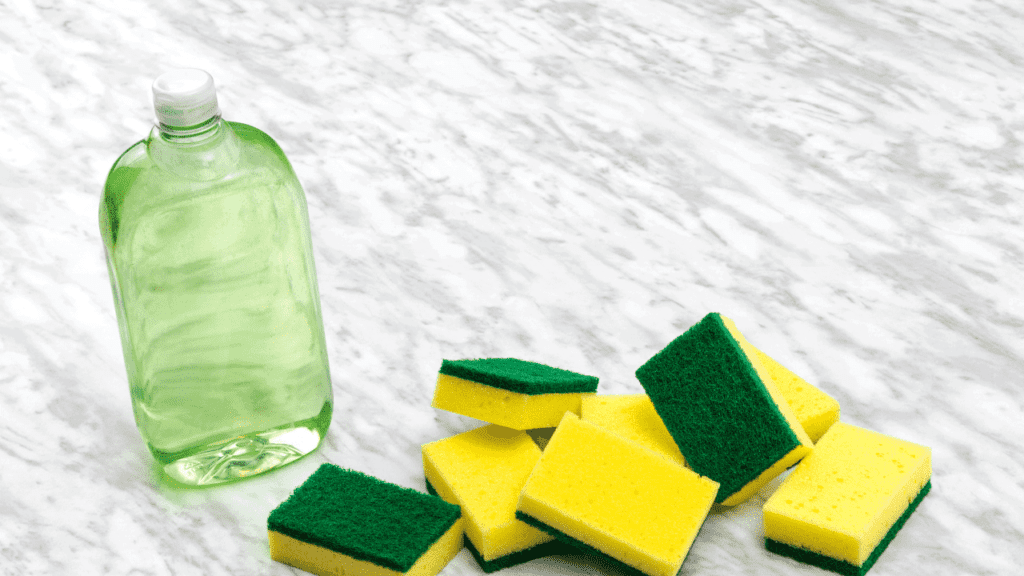Marble is nature’s stunning masterpiece of crystallized carbonate minerals and limestone.
Each piece of marble is unique to its component core, color, and pattern of veins and swirls.
From ancient times, marble has been mined to be utilized in sculpturing and construction.
In modern times, marble is most commonly used in the making of tiles for use around the house and as countertops, because of its durability and elegance.
And with most of its use in the bathroom and kitchen, it is most vulnerable to water stains in these areas.
But suppliers make sure that they prepare the marble before it is sent out to use.
The marble surface is covered with protective layers enhancing its stain and water-resistant properties.
Table of Contents
How To Remove Water Stains From Marble
Water stains on marble surfaces can be easily cleaned with a soft microfiber cloth and warm water. If this doesn’t help, use a cleaning solution made with mild dishwashing soap or baking soda and water to aid the wiping. And if the water stains are much more stubborn, try cleaning them off with any of the marble cleaning products available in the market. Always wipe the marble with a clean damp cloth and then dry off the surface at the end of the cleaning to prevent any residual water stains on the marble surface. Water stains are usually due to hard water components left on the surface, so the best way to reduce them is to prevent them from happening in the first place.
Basic Cleaning Of The Marble Surface
Marble surfaces require regular cleaning and maintenance with the right type of solutions that do not react with them and thus, damage them.
The easiest way to clean a marble surface is to wipe it with a soft microfiber cloth and warm water.
In case of bigger exposure to water, for instance, marble tiles in the shower, make sure you are wiping clean the marble surfaces or at least having some sort of drying atmosphere, like exhaust ventilation after the shower.
For more detailed monthly/biweekly cleaning of the marble surface, you could use a mild solution of water with one of two options; neutral-pH dishwashing soap or baking soda.
Since both these cleaning agents have a mild abrasive effect, make sure that you are giving gaps of about a week or two between deep cleaning with these chemicals.
And also be careful not to let the solutions stay in contact with the marble surfaces for too long.
Another factor to keep in mind is that you are gentle with the cleaning and use a soft microfiber cloth.
Wipe clean the marble surface with a damp cloth after removing the solutions, so there is no residue of any cleaning agent on the surface.
And finally, finish off the process of cleaning by using a dry microfiber cloth to buff the marble surface in a large circular motion.
Tougher Stains On The Marble Surface
In case of stronger stains, such as those of hard water around fixtures and drains, you could use the softest available steel wool ball or a soft-bristled brush to scrub the deposits and stains.
Be careful when you have a water ring on the marble surface to make sure if it is just the water stain and not a dripped drink that may have led to etching.
If it is etched by any acidic chemical, might even be tea, then you would need to restore the marble surface after cleaning off the mark.
You could use marble polishing compounds with a buffing pad to polish the spot.
And for stains from cleaning/bath products, the no-rub method is to place a soaked white towel in hydrogen peroxide over the stain for a few minutes and then wipe it off.
Another solution that you can use for cleaning the marble surface is the commercially available marble cleaners.
Be careful of the dilution and use instructions.
What Not To Use On Marble
Since marble is made up of limestone and carbonate minerals, it is alkali in nature and is readily damaged and eroded by acids.
Cleaners that may contain any sort of acids, even in the mildest forms as vinegar and lemon juice can dissolve the surface of the marble making it uneven and rough.
This is also the reason why outdoor marble structures and sculptures get damaged by acid rain.
Moreover, chlorinated and ammonia-containing products should also be avoided on marble surfaces.
Scrubby tools like brushes and scrubbers can also damage the protective layers on top of the marble and scratch the mineral compound.
An odd way to explain this would be to compare it with teeth, which are also carbonated materials and minerals.
Similar to how teeth are vulnerable to calcareous decay with use and with exposure to enzymes, acids, and food, marble surfaces have a more-or-less similar structure and similar results from exposure to acids.
Pro-Tips To Keep The Marble Top-Notch
In case of being used as tiles, marble can be damaged by mud and dirt brought into the room/house with feet.
Always have doormats at the entrance and exits of the room and avoid wearing outside shoes onto the marble flooring.
The furniture placed on marble flooring should have pads underneath their feet to avoid scratching of the floor. And when you intend to move the furniture, lift and move it, do not drag.
Brushed marble is recommended for areas of traffic and water exposure as these are slip-resistant, such as in the bathroom.
When attempting to remove the etch marks from a marble surface, try to rub the marble polish at high speed but with gentle hands.
The etching should fade out within 20 seconds, but if does not disappear, add just a bit of pressure and repeat.
And the most important point is that if water does not appear as beads on the marble surface or if the surface feels roughened and darker, it is time to have the resealing done.

